Pier 21 National Historic Site
Pier 21 was designated a national historic site in 1997.
Commemorative plaque: 1055 Marginal Road, Halifax, Nova Scotia
This site witnessed the arrival of approximately one million immigrants, who have enriched the cultural mosaic of Canada. Opened in 1928, Pier 21 served as one of Canada's principal reception centres for immigrants until it closed in 1971. It typifies the large, self-contained immigration facilities that the Canadian government had begun to establish at major ports near the turn of the 20th century. The staff at Pier 21 handled large volumes of immigrants rapidly, checking their citizenship and medical condition, and providing quarantine, detention, customs, and social services.

© Pier 21, Jennyrotten, 2010

© Parks Canada, Ian Doull, 1996

© Pier 21, Michael Sprague, 2009.
Description of historic place
Pier 21 National Historic Site of Canada is part of the immense Ocean Terminals passenger landing quay situated at Piers 20-22 in Halifax Harbour off the city-side street of Terminal Road. It includes the transit shed on Pier 21, which together with the brick Central Bay Office separating Piers 21 and 22, constitutes the centre section of the integrated Ocean Terminals transit building, and serves as the facility’s entrance pavilion. Pier 21 is located on the north edge of the wharves and piers that constitute the public Port of Halifax, just behind the Nova Scotian Hotel and the VIA Rail station to which it is historically linked. Pier 21 is now operated as an immigration museum.
Heritage value
Pier 21 was designated a national historic site of Canada in 1996 to commemorate: its role as a major ocean port-of-entry immigration facility in the post First World War period, and in particular during the years following the Second World War, the last intact example of a highly specialized building type associated with the theme of immigration (because of its high degree of structural and site integrity), its embodiment of the policies, procedures and attitudes of early 20th-century Canadian immigration processes.
The heritage value of Pier 21 National Historic Site of Canada lies in its association with the mid 20th-century immigration experience and its illustration of the type of building designed to accommodate the processing of immigrants during that time period. Pier 21 was constructed in 1928 to provide new integrated passenger landing quays for the Port of Halifax. Much of it was destroyed by fire and rebuilt in 1944. Its new facilities reflected a new mid-20th century streamlining of the immigration process. From 1945-1960 it witnessed the massive stream of post World War II European immigration to Canada, including the arrival of the war brides, an event of national historical significance commemorated by a plaque at this location. Pier 21 closed its doors in 1971 and since has been rehabilitated by the Pier 21 Society as a museum to immigration.
Sources: Historic Sites and Monuments Board of Canada, Minutes, November 1996, December 1998, June 2000; Commemorative Integrity Statement, 2004.
The National Program of Historical Commemoration relies on the participation of Canadians in the identification of places, events and persons of national historic significance. Any member of the public can nominate a topic for consideration by the Historic Sites and Monuments Board of Canada.
- Date modified :